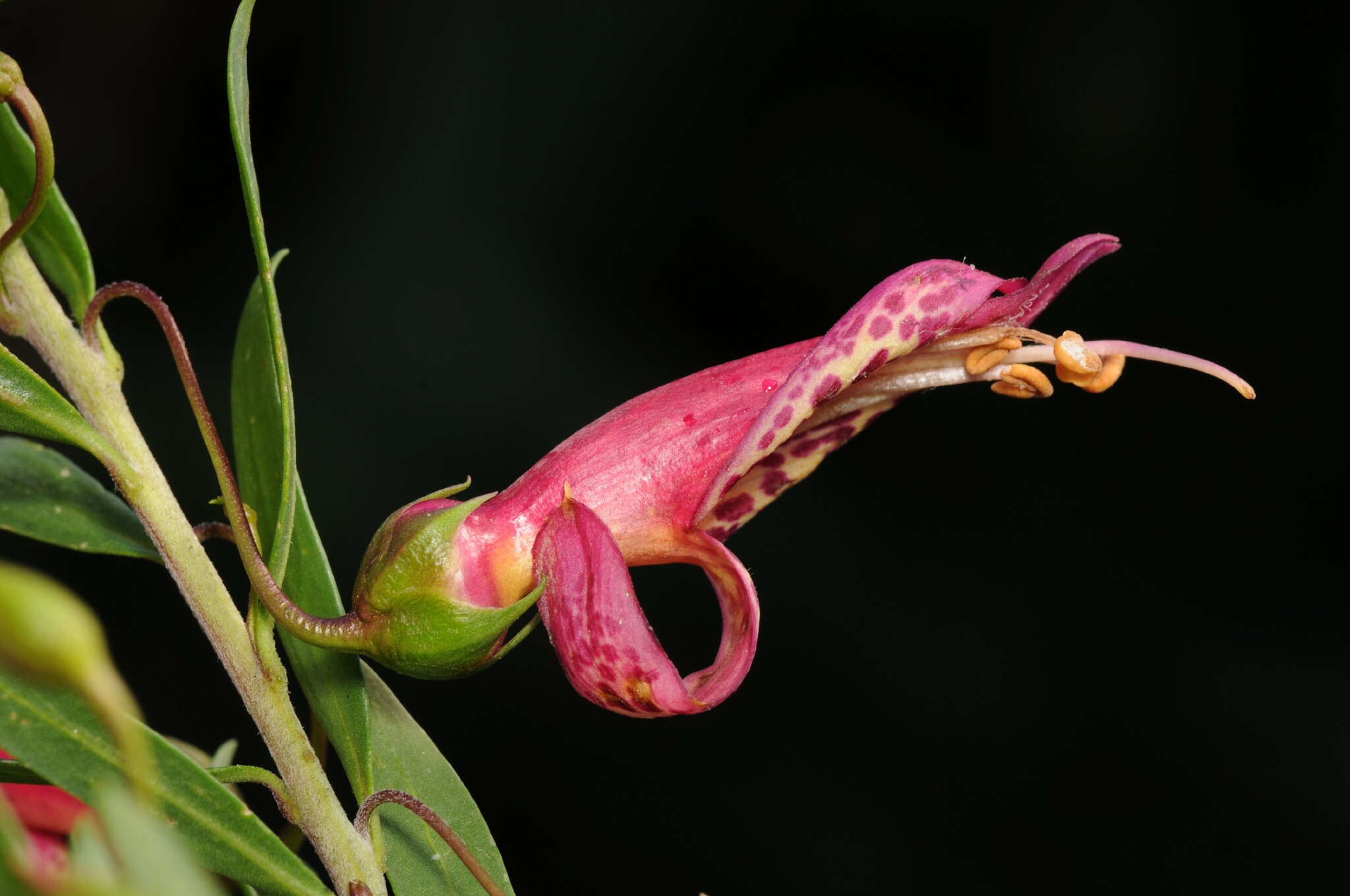
Greek eremophiles — loving the solitude of the desert.
Shrubs and small trees. Leaves alternate or rarely opposite or whorled; margins entire or toothed. Flower clusters axillary, of 1-8 mostly irregular flowers. Sepals free or united, variable, often enlarging after flowering. Flowers 2-lipped, tube often curved, upper lip of 2-4 lobes, lower lip of 1-3 lobes or indistinct. Stamens usually 4, variously arranged. Ovary 2- or 4-chambered. Fruit dry or occasionally drupe-like.
Grown for the range of growth habits and attractive, sometimes grey-white foliage, colourful flowers and calyx lobes. As they are mostly suited to dry-climate gardens, they have the reputation for being difficult and disease prone in cool-climate gardens.
Several species, including E. maculata, are considered poisonous to stock. Some species, such as E. gilesii, have become weedy, especially in Qld and NSW.
Species occasionally available include: E. bowmanii F. Muell., Bowman’s Emubush (Silver Turkeybush), from Qld and NSW, a dwarf to small, densely whitehairy shrub with more or less linear leaves to 5 cm long and 4 mm wide and flowers 1.5–3 cm long, blue to lavender or rarely white and spotted inside; E. drummondii F. Muell. from WA, which has alternate leaves 2–6 cm long, 1 mm wide and flowers violet to blue, the stamens enclosed in the flower; E. longifolia (R. Br.) F. Muell., Emubush (Berrigan), from WA, the NT, SA, Qld, NSW and Vic, which has linear leaves to 20 cm long and 1.5 cm wide with flowers mostly brick red or pinkish; E. nivea Chinnock from WA which is endangered in its natural habitat and can be easily recognised by the white-woolly covering of hair over almost all surfaces, the linear, mostly alternate, leaves 1–2 cm long and the lilac flowers; and E. oppositifolia R. Br., Twin-leaf Emubush (Weeooka), from WA, SA, NSW and Vic, which also has opposite linear leaves but to 2–10 cm long and 3 mm wide with flowers a characteristic cream-pink with stamens parallel to one another and protruding.
Rarely cultivated species include: E. bignoniiflora (Benth.) F. Muell., Bignonia Emubush (Creek Wilga, Eurah), from WA, the NT, SA, Qld, NSW and Vic, a slightly sticky shrub to 5 m or more tall with narrowly lanceolate leaves 3-16 cm long, 1.5 cm wide, flowers creamy with a pink tinge and spotted inside; E. calorhabdos Diels from WA, Red Rod (Spiked Eremophila), an upright shrub with more or less oblong leaves to 2.5 cm long and pink, red or purple flowers to about 3 cm long with protruding stamens; E. debilis (Andr.) Chinnock from New Zealand, a low, trailing shrub with thin reddish branchlets, linear-lanceolate leaves and purplish flowers with stamens that do not protrude [Myoporum debile (Andr.) R. Br.]; E. gibbifolia (F. Muell.) F. Muell., Coccid Emubush, from Vic and SA which has distinctive, small, warty leaves to about 0.5 cm long and 1 mm wide, but generally smaller, the flowers purple or white; E. laanii F. Muell. from WA, a shrub to 3 m tall with white or pale to deep reddish pink flowers that have protruding stamens; and E. macdonnellii F. Muell. from the NT, SA, Qld and NSW, a variable ornamental shrub with variable alternate leaves 3-3.5 cm long, a deep calyx tube, and purple flowers 2-3.5 cm long that are white with purple spots inside.
Seed, cuttings and occasionally by grafting or by transplanting suckers.
Several species were used as medicines by Aborigines. E. mitchellii contains a fragrant oil. A few species have been used as fodder for stock.
Flowers irregular with 4 stamens; fruit dry.
About 215 species from Australia (mostly WA) with 1 from New Zealand.
Source: (2002). Myoporaceae. In: . Horticultural Flora of South-eastern Australia. Volume 4. Flowering plants. Dicotyledons. Part 3. The identification of garden and cultivated plants. University of New South Wales Press.
